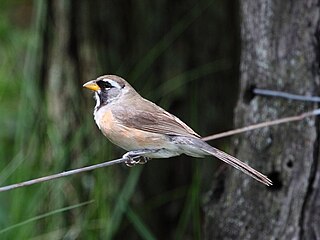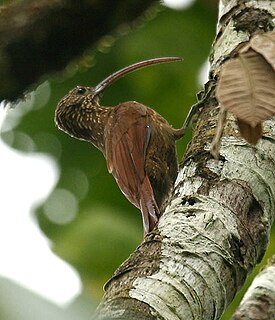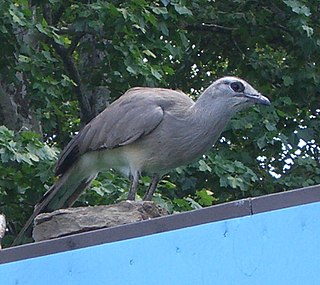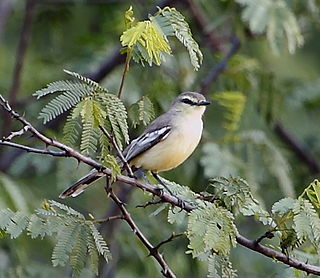 W
WThe rufous casiornis is a species of bird in the family Tyrannidae. It is found in northern Argentina, Bolivia, mid-central Brazil, Paraguay, and northeastern Uruguay; it is a vagrant to eastern Peru and more northern parts of the Amazon Rainforest. Its natural habitats are subtropical or tropical dry forests and subtropical or tropical moist lowland forests.
 W
WThe Chaco chachalaca is a species of bird in the family Cracidae. It is found in Argentina, Bolivia, Brazil, Paraguay, and Uruguay. Its natural habitats are subtropical or tropical dry forest and subtropical or tropical moist lowland forest.
 W
WThe red-tailed comet is a medium-sized hummingbird belonging to the family Trochilidae.
 W
WThe white-winged coot is a species of bird in the family Rallidae. At 35–43 cm (14–17 in) in length, it is a mid-sized coot. It is found in swamps and at lakes in southern South America, including the Falkland Islands, ranging as far north as Bolivia and southern Brazil. Despite its name, most of its wings are dark slaty, though in flight a white trailing edge is visible on the secondaries.
 W
WThe olive-crowned crescentchest is a species of bird in the family Melanopareiidae. It is found in Argentina, Bolivia and Paraguay.
 W
WThe Chaco eagle or crowned solitary eagle, is an endangered bird of prey from eastern and central South America. Typically it is known simply as the crowned eagle which leads to potential confusion with the African Stephanoaetus coronatus. Due to its rarity, not much is known about its biology or population.
 W
WThe Chaco earthcreeper is a species of bird in the family Furnariidae. It is found in Argentina, Bolivia, and Paraguay. Its natural habitat is subtropical or tropical dry shrubland.
 W
WThe many-colored Chaco finch is a songbird found in or near dry woodland in south-central South America in Argentina, Bolivia, Uruguay and Paraguay. Evidence suggests it is a finch-like tanager.
 W
WThe crested gallito is a species of bird in the family Rhinocryptidae. It is monotypic within the genus Rhinocrypta. It is found in Argentina, Bolivia, and Paraguay, where its natural habitats are subtropical or tropical dry forests and subtropical or tropical dry shrubland.
 W
WThe plain inezia or plain tyrannulet is a species of bird in the family Tyrannidae. It is found in Argentina, Bolivia, Brazil, Paraguay, and Peru.
 W
WThe blue-throated macaw, also known as the Caninde macaw or Wagler's macaw, is a macaw endemic to a small area of north-central Bolivia, known as Los Llanos de Moxos. In 2014 this species was designated by law as a natural patrimony of Bolivia, where it is known as barba azul, which means 'blue beard' in Spanish. Until 2010, it was hunted by natives to make feathered "Moxeño" headdresses for "machetero" ritual dances.
 W
WThe Chaco owl is an owl which inhabits dry Chaco woodland in southern Bolivia, western Paraguay and northern Argentina.
 W
WThe blue-crowned parakeet, blue-crowned conure, blue-crowned budgie, or sharp-tailed conure is a small green Neotropical parrot with a blue head and pale beak native to large parts of South America, from eastern Colombia in the north to northern Argentina in the south. They inhabit savanna-like habitats, woodland and forest margins, but avoid dense humid forest such as the Amazon.
 W
WThe green-cheeked conure is a small parrot of the genus Pyrrhura, which is part of a long-tailed group of the New World parrot subfamily Arinae. This type of parrot is generally called a conure in aviculture. It is native to the forests of South America.
 W
WThe Chaco puffbird or streak-bellied puffbird, is a species of bird in the family Bucconidae, the puffbirds. It is found in eastern Bolivia to south-central Brazil, south through western Paraguay to central Argentina. It is found in various open to semi-open habitats, ranging from to semi-humid woodland along the lower Amazon River. It is generally fairly common. The Caatinga puffbird was formerly considered conspecific, together called the spot-backed puffbird. Some taxonomic authorities, including the American Ornithological Society, continue to classify it there.
 W
WThe red-billed scythebill is a species of bird in the Dendrocolaptinae subfamily.
 W
WThe black-legged seriema is one of two living species of seriemas in the family Cariamidae. It is found in Argentina, Bolivia, and Paraguay. Its natural habitats are subtropical or tropical dry forests and subtropical or tropical dry shrubland.
 W
WThe stripe-capped sparrow is a species of bird in the family Passerellidae. It is found in Argentina, western Paraguay and southeastern Bolivia. Its natural habitats are subtropical or tropical dry forests and subtropical or tropical dry shrubland.
 W
WThe ochre-cheeked spinetail is a species of bird in the family Furnariidae. It is found in Bolivia, Brazil and northwestern Argentina. Its natural habitats are subtropical or tropical dry forests and subtropical or tropical moist lowland forests.
 W
WSick's swift is a species of swift in the family Apodidae. It was previously considered conspecific with the smaller ashy-tailed swift, but Marín (1997) found that Sick's swift was closer to the chimney swift. It is a migratory species that breeds in central South America and overwinters in northern South America. The IUCN has listed it as being of "Least Concern".
 W
WThe little thornbird is a species of bird in the family Furnariidae. It is found in Argentina, Bolivia, Paraguay, and Uruguay. Its natural habitats are subtropical or tropical dry forest and subtropical or tropical dry shrubland.
 W
WLetitia's thorntail, also known as the coppery thorntail, is a species of hummingbird in the family Trochilidae. It is only known from two old male specimens from Bolivia. Consequently, its behavior and habitat are unknown, but likely similar to that of other thorntails. It has been suggested that it represented a hybrid or a variant of the racquet-tailed coquette, but a study has validated its status as a distinct species.
 W
WThe brushland tinamou is a type of Tinamou commonly found in high-altitude dry shrubland in subtropical and tropical regions of southern South America.
 W
WThe Tataupa tinamou is a type of tinamou commonly found in dry forest in subtropical and tropical regions in southeastern South America.
 W
WThe cinereous tyrant is a species of bird in the family Tyrannidae. The term cinereous describes its colouration. It inhabits the Gran Chaco, where Its natural habitat is subtropical or tropical dry shrubland.
 W
WThe greater wagtail-tyrant is a South American species of bird in the family Tyrannidae. A small bird, but larger than the related lesser wagtail-tyrant. The greater wagtail-tyrant occurs in two distinct populations: One in woodland and shrub in southeastern Bolivia, western Paraguay, and central and northwestern Argentina, and a second in the Caatinga region in northeastern Brazil. The latter is sometimes considered a separate species, the Caatinga wagtail-tyrant.
 W
WThe great rufous woodcreeper is a species of bird in the Dendrocolaptinae subfamily, the woodcreepers. It is found in Argentina, Bolivia, Brazil, and Paraguay. Its natural habitats are subtropical or tropical dry forests and subtropical or tropical moist lowland forests. At 155 g (5.5 oz) and 35 cm (14 in), this is the largest woodcreeper and, if correctly allied with the family, is the largest furnariid.
 W
WThe cream-backed woodpecker is a species of bird in the family Picidae. It is found in Argentina, Bolivia, Brazil, Paraguay and far northwestern Uruguay. Its natural habitat is subtropical or tropical dry forests.
 W
WThe white-fronted woodpecker is a species of bird in the family Picidae. It is found mainly in Bolivia, Paraguay and Argentina. Its natural habitats are subtropical or tropical dry forests, subtropical or tropical dry shrubland, and subtropical or tropical high-altitude shrubland.